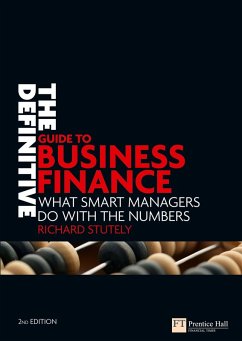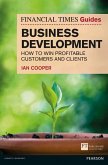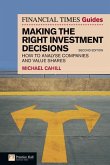Richard Stutely
Definitive Guide to Business Finance, The
Richard Stutely
Definitive Guide to Business Finance, The
- Broschiertes Buch
- Merkliste
- Auf die Merkliste
- Bewerten Bewerten
- Teilen
- Produkt teilen
- Produkterinnerung
- Produkterinnerung
Richard Stutely achieves what you might think is impossible, making business finance easy with an amusing, wry and common sense style that will make you wonder what you ever worried about. This book is a survival toolkit on the financial essentials. It assumes no specialised prior knowledge of finance and takes a guided step-by-step approach to all the techniques and concepts you need to understand, explaining the hows, whats and whys along the way. To make things even easier, it shows you how to use basic Excel spreadsheets to do all the calculations for you. Throughout the book, Richard…mehr
Andere Kunden interessierten sich auch für
![Financial Times Guide to Understanding Finance, The Financial Times Guide to Understanding Finance, The]() Javier EstradaFinancial Times Guide to Understanding Finance, The29,99 €
Javier EstradaFinancial Times Guide to Understanding Finance, The29,99 €![The Lifestyle Investor The Lifestyle Investor]() Justin DonaldThe Lifestyle Investor24,99 €
Justin DonaldThe Lifestyle Investor24,99 €![Financial Times Essential Guide to Budgeting and Forecasting, The Financial Times Essential Guide to Budgeting and Forecasting, The]() Nigel WyattFinancial Times Essential Guide to Budgeting and Forecasting, The14,99 €
Nigel WyattFinancial Times Essential Guide to Budgeting and Forecasting, The14,99 €![Financial Times Guide to Business Development, The Financial Times Guide to Business Development, The]() Ian CooperFinancial Times Guide to Business Development, The19,99 €
Ian CooperFinancial Times Guide to Business Development, The19,99 €![Financial Times Guide to Business Coaching, The Financial Times Guide to Business Coaching, The]() Anne ScoularFinancial Times Guide to Business Coaching, The24,99 €
Anne ScoularFinancial Times Guide to Business Coaching, The24,99 €![Financial Times Guide to Making the Right Investment Decisions, The Financial Times Guide to Making the Right Investment Decisions, The]() Michael CahillFinancial Times Guide to Making the Right Investment Decisions, The25,99 €
Michael CahillFinancial Times Guide to Making the Right Investment Decisions, The25,99 €![Financial Times Guide to Wealth Management, The Financial Times Guide to Wealth Management, The]() Jason ButlerFinancial Times Guide to Wealth Management, The49,99 €
Jason ButlerFinancial Times Guide to Wealth Management, The49,99 €-
-
-
Richard Stutely achieves what you might think is impossible, making business finance easy with an amusing, wry and common sense style that will make you wonder what you ever worried about. This book is a survival toolkit on the financial essentials. It assumes no specialised prior knowledge of finance and takes a guided step-by-step approach to all the techniques and concepts you need to understand, explaining the hows, whats and whys along the way. To make things even easier, it shows you how to use basic Excel spreadsheets to do all the calculations for you. Throughout the book, Richard Stutely shoes you how to crack the jargon and unveils shortcuts, tips and tricks that will make you look like a financial wizard. If you're not yet a whiz with the numbers, you can definitely use this book to your advantage. If you're already a whiz, you will still find something new to improve your skills. Make the numbers add up for you.
Produktdetails
- Produktdetails
- Financial Times Series
- Verlag: Pearson Education Limited
- 2 ed
- Seitenzahl: 432
- Erscheinungstermin: 14. Dezember 2006
- Englisch
- Abmessung: 240mm x 170mm x 24mm
- Gewicht: 726g
- ISBN-13: 9780273710950
- ISBN-10: 0273710958
- Artikelnr.: 22431584
- Herstellerkennzeichnung Die Herstellerinformationen sind derzeit nicht verfügbar.
- Financial Times Series
- Verlag: Pearson Education Limited
- 2 ed
- Seitenzahl: 432
- Erscheinungstermin: 14. Dezember 2006
- Englisch
- Abmessung: 240mm x 170mm x 24mm
- Gewicht: 726g
- ISBN-13: 9780273710950
- ISBN-10: 0273710958
- Artikelnr.: 22431584
- Herstellerkennzeichnung Die Herstellerinformationen sind derzeit nicht verfügbar.
Businessman and author Richard Stutely has written many other books including The Economist Guide to Economic Indicators (1861974671 and has written extensively for publications such as The Economist, The Accountant and The Banker
Chapter 1. The Journey Starts Here Part 1. Attaining mastery over numbers
First, I will help you suit up with the weapons and armour needed to do
battle.
Chapter 2 Where Managers and Numbers Meet reviews this magical kingdom and
starts to show you how to use the numbers to your advantage.
Chapter 3 How The Finance Director Thinks looks at mindset of the
professionals with whom you will be dealing.
Chapter 4 The Financial Wizard's Toolbox investigates the tools you use to
hammer the numbers primarily spreadsheets.
Chapter 5 Taming Numbers provides a refresher about some numerical
techniques.
Patr 2. Managing moneySecond, now you are forearmed, we can move on to
income and expenditure. I will show you how to dominate every penny that
comes into and flows out of your coffers.
Chapter 6 Keeping Score reviews the rudiments of bookkeeping, with a
special note on matters such as looking after the petty cash and dealing
with expenses claims.
Chapter 7 How to Analyze Figures in the Fourth Dimension introduces ways of
looking at how numbers have changed over time and how this highlights what
is happening to the business.
Chapter 8 How to Forecast Anything explains how to form a realistic view
about potential future trends with particular attention on forecasting
sales.
Chapter 9 Getting to Gross Profit touches on broader aspects of sales
revenue.
Chapter 10 Creating Capital considers the special factors surrounding
capital spending (often huge outlays where there is longer-term benefit and
perhaps short-term pain).
Chapter 11 Controlling Costs looks at other spending the cash that seems to
go up in smoke instantly when you pay telephone bills, rent, and so on.
Part 3. Doing the numbersNow you have a good understanding of number
crunching techniques, as well as hands-on experience dealing with the
figures that finance your business. You are now ready to pull them together
for some serious business reporting, analysis and decision-making, and
control.
Chapter 12 Brilliant Budgets reviews the budgeting process.
Chapter 13 Perfect Projects reveals the secrets of killer project
management feasibility studies, planning, decision and control. Good stuff
applicable everywhere in surprising ways.
Chapter 14 Producing a Profit investigates income statements, known in the
UK and elsewhere as profit and loss accounts. These are just budgets or
project plans restated.
Chapter 15 Building a Balance Sheet looks at balance sheets misunderstood
(to say the least) medical reports about of the health of any business.
Chapter 16 Controlling Cash Flow considers sources and uses of funds
highlighting ways of re-casting the figures already dealt with to give you
better management control over cash.
Part 4. Managing betterBy now, you are all set for success. Chapter 17
Seeing the Big Picture looks at how you pull all the components together
and how individual figures relate to and mesh with those of the enterprise
as a whole. Chapter 18 Making Better Financial Decisions aim to help you
do just that covering questions such as how profitable is my business,
which product lines are most profitable, and which business units are most
vulnerable. Chapter 19 Managing the Numbers will let you manage financials
better on a daily basis with shortcuts to incisive analysis, tips for
handling financial meetings, presentations and beanies, and so on. Chapter
20. When Things Go Wrong deals with the inevitable what to do when things
go wrong; things such as cost overruns, econom
First, I will help you suit up with the weapons and armour needed to do
battle.
Chapter 2 Where Managers and Numbers Meet reviews this magical kingdom and
starts to show you how to use the numbers to your advantage.
Chapter 3 How The Finance Director Thinks looks at mindset of the
professionals with whom you will be dealing.
Chapter 4 The Financial Wizard's Toolbox investigates the tools you use to
hammer the numbers primarily spreadsheets.
Chapter 5 Taming Numbers provides a refresher about some numerical
techniques.
Patr 2. Managing moneySecond, now you are forearmed, we can move on to
income and expenditure. I will show you how to dominate every penny that
comes into and flows out of your coffers.
Chapter 6 Keeping Score reviews the rudiments of bookkeeping, with a
special note on matters such as looking after the petty cash and dealing
with expenses claims.
Chapter 7 How to Analyze Figures in the Fourth Dimension introduces ways of
looking at how numbers have changed over time and how this highlights what
is happening to the business.
Chapter 8 How to Forecast Anything explains how to form a realistic view
about potential future trends with particular attention on forecasting
sales.
Chapter 9 Getting to Gross Profit touches on broader aspects of sales
revenue.
Chapter 10 Creating Capital considers the special factors surrounding
capital spending (often huge outlays where there is longer-term benefit and
perhaps short-term pain).
Chapter 11 Controlling Costs looks at other spending the cash that seems to
go up in smoke instantly when you pay telephone bills, rent, and so on.
Part 3. Doing the numbersNow you have a good understanding of number
crunching techniques, as well as hands-on experience dealing with the
figures that finance your business. You are now ready to pull them together
for some serious business reporting, analysis and decision-making, and
control.
Chapter 12 Brilliant Budgets reviews the budgeting process.
Chapter 13 Perfect Projects reveals the secrets of killer project
management feasibility studies, planning, decision and control. Good stuff
applicable everywhere in surprising ways.
Chapter 14 Producing a Profit investigates income statements, known in the
UK and elsewhere as profit and loss accounts. These are just budgets or
project plans restated.
Chapter 15 Building a Balance Sheet looks at balance sheets misunderstood
(to say the least) medical reports about of the health of any business.
Chapter 16 Controlling Cash Flow considers sources and uses of funds
highlighting ways of re-casting the figures already dealt with to give you
better management control over cash.
Part 4. Managing betterBy now, you are all set for success. Chapter 17
Seeing the Big Picture looks at how you pull all the components together
and how individual figures relate to and mesh with those of the enterprise
as a whole. Chapter 18 Making Better Financial Decisions aim to help you
do just that covering questions such as how profitable is my business,
which product lines are most profitable, and which business units are most
vulnerable. Chapter 19 Managing the Numbers will let you manage financials
better on a daily basis with shortcuts to incisive analysis, tips for
handling financial meetings, presentations and beanies, and so on. Chapter
20. When Things Go Wrong deals with the inevitable what to do when things
go wrong; things such as cost overruns, econom
Chapter 1. The Journey Starts Here Part 1. Attaining mastery over numbers
First, I will help you suit up with the weapons and armour needed to do
battle.
Chapter 2 Where Managers and Numbers Meet reviews this magical kingdom and
starts to show you how to use the numbers to your advantage.
Chapter 3 How The Finance Director Thinks looks at mindset of the
professionals with whom you will be dealing.
Chapter 4 The Financial Wizard's Toolbox investigates the tools you use to
hammer the numbers primarily spreadsheets.
Chapter 5 Taming Numbers provides a refresher about some numerical
techniques.
Patr 2. Managing moneySecond, now you are forearmed, we can move on to
income and expenditure. I will show you how to dominate every penny that
comes into and flows out of your coffers.
Chapter 6 Keeping Score reviews the rudiments of bookkeeping, with a
special note on matters such as looking after the petty cash and dealing
with expenses claims.
Chapter 7 How to Analyze Figures in the Fourth Dimension introduces ways of
looking at how numbers have changed over time and how this highlights what
is happening to the business.
Chapter 8 How to Forecast Anything explains how to form a realistic view
about potential future trends with particular attention on forecasting
sales.
Chapter 9 Getting to Gross Profit touches on broader aspects of sales
revenue.
Chapter 10 Creating Capital considers the special factors surrounding
capital spending (often huge outlays where there is longer-term benefit and
perhaps short-term pain).
Chapter 11 Controlling Costs looks at other spending the cash that seems to
go up in smoke instantly when you pay telephone bills, rent, and so on.
Part 3. Doing the numbersNow you have a good understanding of number
crunching techniques, as well as hands-on experience dealing with the
figures that finance your business. You are now ready to pull them together
for some serious business reporting, analysis and decision-making, and
control.
Chapter 12 Brilliant Budgets reviews the budgeting process.
Chapter 13 Perfect Projects reveals the secrets of killer project
management feasibility studies, planning, decision and control. Good stuff
applicable everywhere in surprising ways.
Chapter 14 Producing a Profit investigates income statements, known in the
UK and elsewhere as profit and loss accounts. These are just budgets or
project plans restated.
Chapter 15 Building a Balance Sheet looks at balance sheets misunderstood
(to say the least) medical reports about of the health of any business.
Chapter 16 Controlling Cash Flow considers sources and uses of funds
highlighting ways of re-casting the figures already dealt with to give you
better management control over cash.
Part 4. Managing betterBy now, you are all set for success. Chapter 17
Seeing the Big Picture looks at how you pull all the components together
and how individual figures relate to and mesh with those of the enterprise
as a whole. Chapter 18 Making Better Financial Decisions aim to help you
do just that covering questions such as how profitable is my business,
which product lines are most profitable, and which business units are most
vulnerable. Chapter 19 Managing the Numbers will let you manage financials
better on a daily basis with shortcuts to incisive analysis, tips for
handling financial meetings, presentations and beanies, and so on. Chapter
20. When Things Go Wrong deals with the inevitable what to do when things
go wrong; things such as cost overruns, econom
First, I will help you suit up with the weapons and armour needed to do
battle.
Chapter 2 Where Managers and Numbers Meet reviews this magical kingdom and
starts to show you how to use the numbers to your advantage.
Chapter 3 How The Finance Director Thinks looks at mindset of the
professionals with whom you will be dealing.
Chapter 4 The Financial Wizard's Toolbox investigates the tools you use to
hammer the numbers primarily spreadsheets.
Chapter 5 Taming Numbers provides a refresher about some numerical
techniques.
Patr 2. Managing moneySecond, now you are forearmed, we can move on to
income and expenditure. I will show you how to dominate every penny that
comes into and flows out of your coffers.
Chapter 6 Keeping Score reviews the rudiments of bookkeeping, with a
special note on matters such as looking after the petty cash and dealing
with expenses claims.
Chapter 7 How to Analyze Figures in the Fourth Dimension introduces ways of
looking at how numbers have changed over time and how this highlights what
is happening to the business.
Chapter 8 How to Forecast Anything explains how to form a realistic view
about potential future trends with particular attention on forecasting
sales.
Chapter 9 Getting to Gross Profit touches on broader aspects of sales
revenue.
Chapter 10 Creating Capital considers the special factors surrounding
capital spending (often huge outlays where there is longer-term benefit and
perhaps short-term pain).
Chapter 11 Controlling Costs looks at other spending the cash that seems to
go up in smoke instantly when you pay telephone bills, rent, and so on.
Part 3. Doing the numbersNow you have a good understanding of number
crunching techniques, as well as hands-on experience dealing with the
figures that finance your business. You are now ready to pull them together
for some serious business reporting, analysis and decision-making, and
control.
Chapter 12 Brilliant Budgets reviews the budgeting process.
Chapter 13 Perfect Projects reveals the secrets of killer project
management feasibility studies, planning, decision and control. Good stuff
applicable everywhere in surprising ways.
Chapter 14 Producing a Profit investigates income statements, known in the
UK and elsewhere as profit and loss accounts. These are just budgets or
project plans restated.
Chapter 15 Building a Balance Sheet looks at balance sheets misunderstood
(to say the least) medical reports about of the health of any business.
Chapter 16 Controlling Cash Flow considers sources and uses of funds
highlighting ways of re-casting the figures already dealt with to give you
better management control over cash.
Part 4. Managing betterBy now, you are all set for success. Chapter 17
Seeing the Big Picture looks at how you pull all the components together
and how individual figures relate to and mesh with those of the enterprise
as a whole. Chapter 18 Making Better Financial Decisions aim to help you
do just that covering questions such as how profitable is my business,
which product lines are most profitable, and which business units are most
vulnerable. Chapter 19 Managing the Numbers will let you manage financials
better on a daily basis with shortcuts to incisive analysis, tips for
handling financial meetings, presentations and beanies, and so on. Chapter
20. When Things Go Wrong deals with the inevitable what to do when things
go wrong; things such as cost overruns, econom








